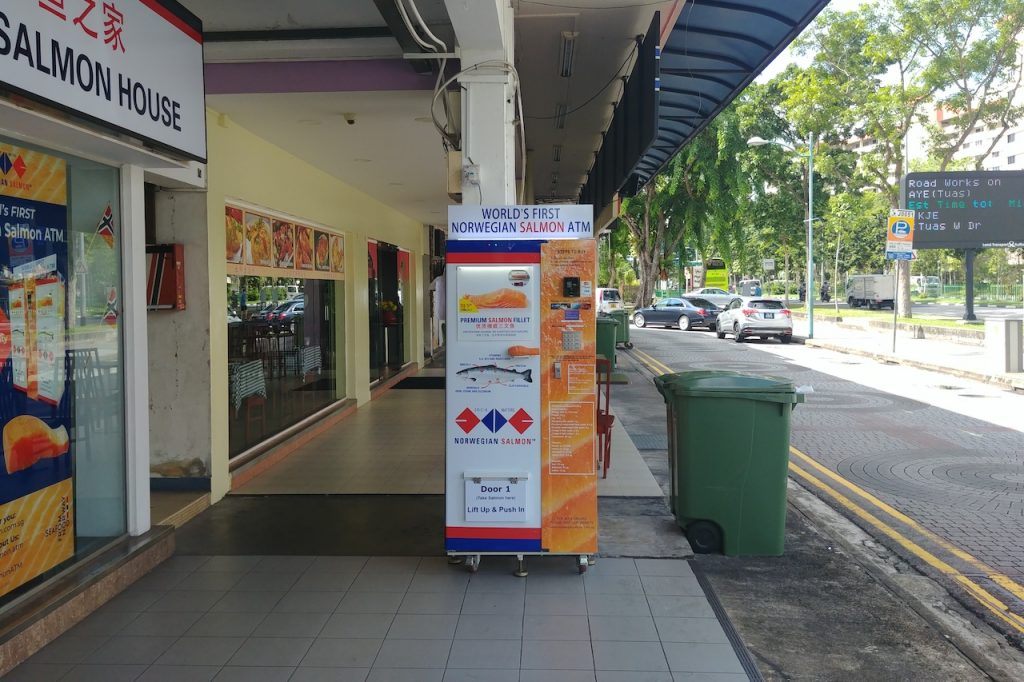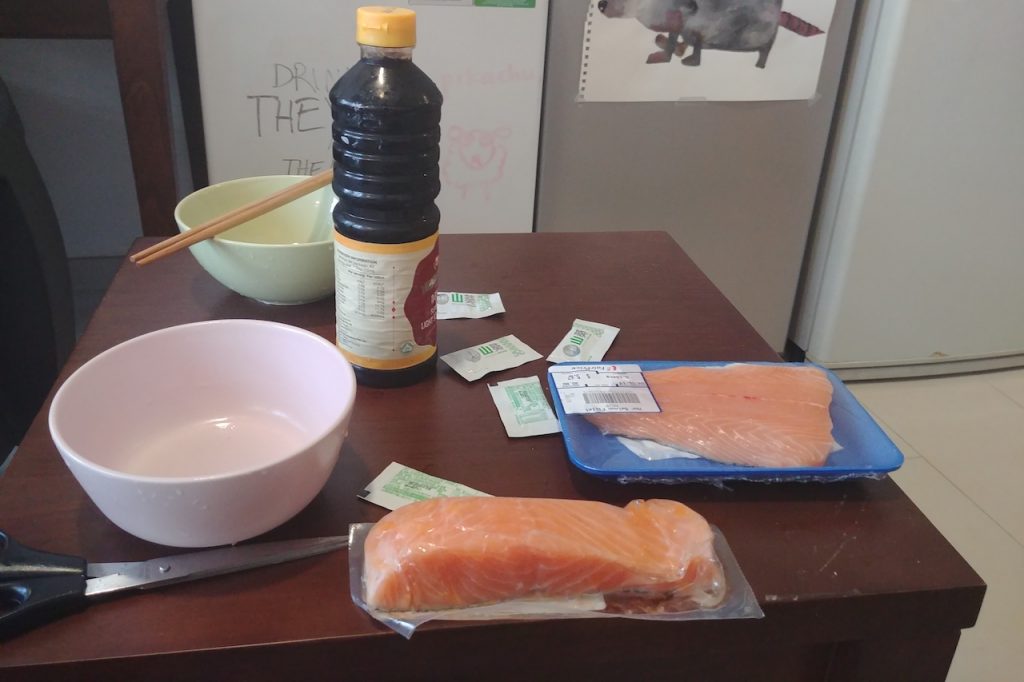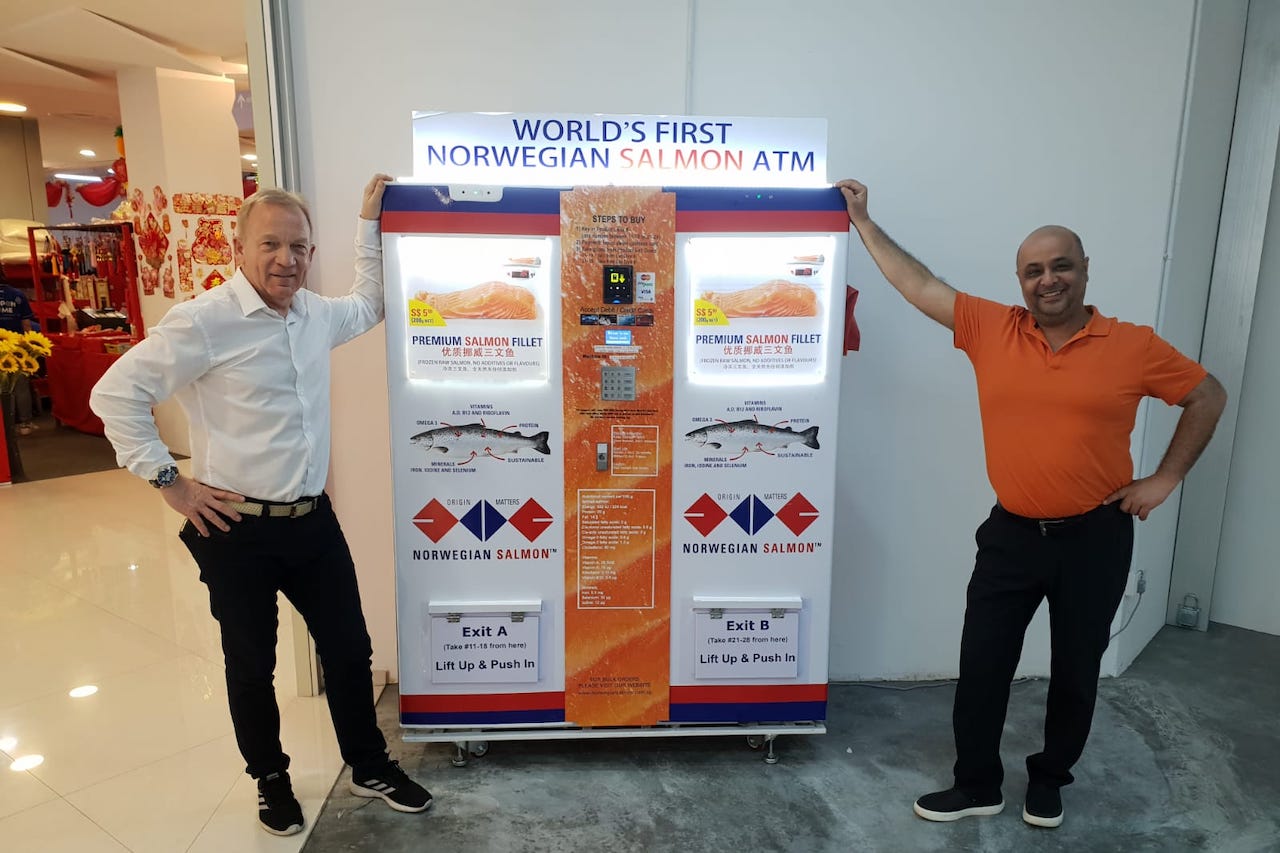As it turns out, I was wrong.
When I walk into the large reception area, there is only one receptionist sitting behind a desk. She brings me to the office of Norwegian Salmon Pte Ltd’s founder and CEO—Mr Manish Kumar.
His desk is covered with plastic replicas of the 200-gram salmon fillets that can be bought for $5.90 from any Norwegian Salmon ATM. His walls are painted with three horizontal stripes of white, red, and blue, which represent the flag of his home country.
I assumed that Mr Kumar was Singaporean and just using the Norwegian label for marketing. I am surprised to hear he is actually from Norway.
Mr Kumar is quite a bit taller than me, probably around 185 CM. He gives me a firm but cordial handshake across his desk before we sit down for our interview. He is wearing a very comfortable looking button-down white shirt.

“The motivation for the Norwegian Salmon ATM was to make Norwegian salmon time- and cost-effective for everyday people. We put the nutrition facts for our salmon on the front of every ATM because we are proud of how healthy it is,” he explains.
I’ve never really thought of salmon as a health food, but a quick Google search reveals a BBC article extolling the many benefits of salmon, calling it a ‘superfood’. I also come across articles pointing out the many health and ethical issues of both farmed and wild-caught salmon.
However, after doing further due diligence on Seafood Watch, I find that “premium” farmed Norwegian salmon really is the gold standard when it comes to health and sustainability. While it might not be perfect, the Norwegian salmon sold by Mr Kumar’s ATMs is likely to be far healthier and sustainable than most of what we eat.
Mr Kumar says that he has been in the salmon industry his entire life. At SalMar, Norway’s largest farmed salmon producer, he had worked in slaughtering, packaging, and many other positions before becoming Head of Sales in Asia.
He told me that his inspiration to create a salmon ATM came during a business trip to India in 2009. Many distributors had shared a similar problem: Salmon is a luxury food that middle-class people wouldn’t buy.
“After that trip to India, I thought a lot about how to make Norwegian Salmon time- and cost-effective, and settled on the idea of a salmon vending machine. Not only does it take away the need for costly staff, storefront and distributor fees, it also makes it more convenient by making it available 24 hours a day.”
“In fact, I can see when people use our ATMs here in Singapore and there have been many cases where customers buy salmon after midnight,” he adds.

With anywhere in the world to set up Norwegian Salmon Pte Ltd, including his beloved Norway, I wonder why Mr Kumar chose Singapore.
He tells me that Norway does not have the same robust “vending machine culture” that Asia has. Originally, he wanted to set up shop in Hong Kong, but found the language barrier a significant hindrance to business.
On top of that, Norway and Singapore have a visa-free import programme for salmon, which makes importing to Singapore relatively cheap and convenient compared to other countries in Southeast Asia. It was here in Singapore too, that Mr Kumar met his technology partner which produces the ATMs integral to his business.
Frankly, I am still sceptical of the long-term viability of a business based on salmon dispensed from a vending machine. Even with the inspiring backstory, the idea of buying salmon out of an ATM still seems … weird.
But as I talk to Mr Kumar, my scepticism fades. Norwegian Salmon Pte Ltd is making serious moves.
After presenting at Thaifex in Bangkok, Southeast Asia’s biggest food and beverage trade show in late May, Mr Kumar says he has received a torrent of franchise requests from around the world. Even companies in Sweden, Norway’s neighbour, have indicated their interest. Back in Singapore, the number of Norwegian Salmon ATMs will nearly double to around 100 island-wide by mid-July.
To top it off, Norwegian Salmon Pte Ltd is set to roll out a huge taxi ad campaign.
Mr Kumar shows me the concept for the ads. On 15th June, you’ll be seeing Comfort taxis looking like oversized, mobile fillets of salmon.
I am frankly shocked by how smoothly everything is going for Mr Kumar and his company.
When I ask about the key to his success, he says, “I know the Norwegian salmon industry well, and I am very dedicated to my vision of making Norwegian salmon time- and cost-effective. However, I had to get lucky to find such a good investor and partner, Mr Tore Lyng, and I had to get lucky to have such a good technology partner to actually build the machines.”
I figure that he must be thinking of expanding to other frozen vendable products, but no, he’s a salmon man through and through. He says, “I don’t plan to sell anything besides salmon in my ATMs. There is a reason why its called ‘Norwegian Salmon ATM’ and not ‘frozen fish ATM’. I am working to promote my country’s best product.”

However, I realise that product quality will be what ultimately determines Norwegian Salmon Pte Ltd’s success or failure.
Mr Kumar told me that one of his favourite ways to prepare Norwegian salmon is to slice it while it is defrosting, and then eat it as sashimi once fully defrosted. I decide that the best way to judge his product is to do a sashimi showdown between his ATM salmon fillet, and its supermarket competitors.
A few days later, I swing by the Norwegian Salmon ATM near Clementi Mall and buy 1 unit of its only product, a 200-gram fillet of frozen Norwegian salmon for $5.90. The transaction is incredibly quick and convenient, but I could imagine that going to a separate location from the grocery store just to buy one product might be a barrier for many.
I go to the nearest Fairprice a mere 200 meters away and pick out a 184-gram Norwegian salmon fillet from the refrigerated fish section for $5.67.
By the time I get back to my campus dorm, the frozen fillet is mostly defrosted.
Since I normally only prepare unhealthy garbage such as cereal and instant noodles, I don’t own a kitchen knife. However, I do own a fairly sharp pair of scissors. I attempt to cut the Fair Price fillet with the scissors but only manage to mangle it slightly.
However, the scissors cut the half defrosted Norwegian Salmon fillet perfectly. As a cereal-addict who really does not want to buy a fancy knife, the ATM salmon is already paying dividends.
I wait a bit for the salmon to totally defrost, and then I start dunking the two different salmon fillets in my soy-sauce-wasabi-packet concoction and chow down. The Fairprice fillet frankly looks more appetising. It has a deeper pink colour and a sleeker texture.

After eating about 300 grams of my total 384, I am incredibly sick of raw fish, so I decided to sear my remaining salmon nuggets. This proves to be a wonderful idea. It brings out new and exciting flavours in both the Fairprice and the ATM Salmon.
Again, I find myself strongly preferring the ATM salmon.
After my taste test, I still remain sceptical of Mr Kumar’s two pillars of time and cost-effectiveness; his ATM salmon wasn’t much cheaper than the supermarket’s salmon. Nor did it seem particularly more convenient to buy, unless I wanted to purchase it in the dead of night.
However, I did find the frozen ATM salmon much tastier than its supermarket equivalent. Frozen may truly be the new fresh, as Mr Kumar claims.
However, when I think vending machine, I still think soda and snacks, not premium Norweigan salmon. The challenge now will be getting people to overcome the cognitive barrier. If I wasn’t writing this story, I would never have tried the Norwegian Salmon ATM. But once you get over the utter strangeness of a fish-dispensing ATM, perhaps the product will speak for itself.
After all, who doesn’t like fresh salmon?






